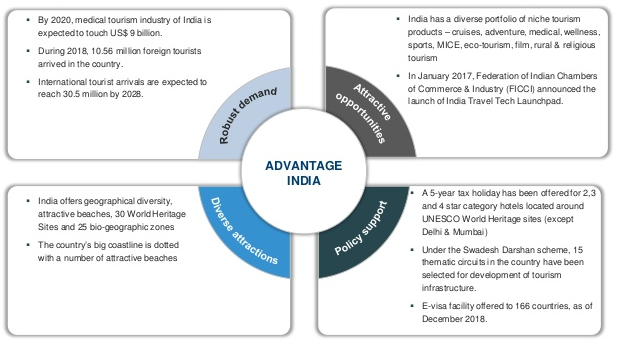Indian Economy
Tourism Industry In India
- 18 Jun 2020
- 8 min read
This article is based on “For tourism, here is an Incredible India 2.0 plan” which was published in The Hindustan Times on 17/06/2020. It talks about underlying challenges and steps to be taken for the promotion of India’s Tourism sector.
The economy runs on the four wheels of demand, supply, capital and labour. Covid-19 pandemic has impacted demand and supply, capital availability and left labour facing unemployment.
Though the pandemic has affected almost every sector of the Indian economy, perhaps the travel, tourism and hospitality sectors have been the most affected. According to the World Travel and Tourism Council, nearly 42 million jobs in the tourism and hospitality sector will be at risk in India.
Given the vital importance of the tourism industry in the Indian economy, there is a need to address underneath challenges and adopt a suitable policy for overall growth.
Importance of Tourism Sector
- Employment Generation: Travel, tourism, and hospitality can exponentially create jobs, which is important for India’s demographic dividend, as 72% of India’s population is below 32 years with the average age of 29.
- Travel and tourism account for approximately 8.1% of the total employment opportunities.
- In 2019, it contributed 9.3% to India’s Gross Domestic Product (GDP) and received 5.9% of total investments.
- Multiplier Effect: An added aspect of the travel and tourism sector is that not only does the sector provide high-quality jobs, it also enhances an investment in India, accelerates development, and showcases India’s unique treasures-acting as a tool for soft diplomacy.
- Potential Areas of Tourism: India offers amazing diversity in tourism, ranging from 38 UNESCO World Heritage sites to the different physiographic features to medical and Wildlife Tourism.
- India is ranked third (behind US and China) in the World Travel and Tourism Council (WTTC)’s Travel and Tourism Power Ranking, 2019.
Note:
World Travel and Tourism Council (WTTC)’s Travel and Tourism Power Ranking assesses nearly 185 countries on the basis of four key sector ingredients: Total travel and tourism GDP, foreign visitor spending, domestic spending, and travel and tourism capital investment.
Underneath Challenges of India’s Tourism Sector
- Entry/exit Issue: Despite the introduction of an e-visa facility, visitors find the process of applying for a visa still cumbersome.
- This process will further get complicated in the post-Covid era.
- Infrastructure and Connectivity: Deficiencies in infrastructure and inadequate connectivity hamper tourist visits to some heritage sites.
- For example, many tourist destinations like Kangchenjunga, are still not easily accessible.
- Tourism segments or circuits: India has various tourist destinations but few circuits. Also, many announced tourist circuits are yet to be implemented on the ground.
- Promotion and Marketing: Although marketing related to India’s tourism has been increasing, still online marketing/branding remains limited and campaigns are not coordinated.
- Tourist information centres are poorly managed, making it difficult for domestic and foreign tourists to access information with ease.
- Skill Deficit: The number of adequately trained individuals for the tourism and hospitality sector is a key challenge to giving visitors a world-class experience.
- A limited number of multi-lingual trained guides, and the limited local awareness and understanding of the benefits and responsibilities associated with the tourism industry act as constraints on the sector’s growth.
Steps To Be Taken
The Prime Minister of India emphasised the importance of making India a global hub for tourism, urging each citizen to visit 15 tourist destinations in India by 2022. In this pursuit:
- Focusing Inward: A campaign focusing on domestic tourism that showcases what the nation offers to Indians could be the post-pandemic plan for the sector.
- Improving Transportation Infrastructure: The UDAN scheme has been a huge success, and now the government can focus on the earlier plans of launching 100 tourism-oriented trains.
- Also, the ease of access can be improved by the faster implementation of Bharatmala and Sagarmala projects.
- Further, the Holistic Island Development plan which focuses on the Andaman & Nicobar (A&N) and Lakshadweep Islands will automatically create jobs for the islanders and enhance connectivity through key infrastructure projects.
- Preserving Heritage: Conservation and development of all heritage sites should be undertaken and completed through either government funding or through NGOs/Corporate Social Responsibility (CSR) activities.
- The Ministry of Tourism’s Swadesh Darshan and National Mission on Pilgrimage Rejuvenation and Spiritual Heritage Augmentation Drive (PRASAD) schemes are already undertaking the development or maintenance of heritage sites.
- The number of projects sanctioned under this scheme should be increased and their implementation accelerated.
- Skill Development: There is a need to connect local communities to tourism by encouraging them to set up small enterprises to supply the tourism industry (accommodation, food and material).
- Employment opportunities can be expanded by ensuring that investors and operators in the organized sector are encouraged to hire staff locally.
- This will give a boost to Eco-tourism.
- Leveraging Technology: Moving forward, technology can play a significant role in creating minimum physical touchpoints in hotels, which is very much required for safe and hygienic tourism.
Conclusion
Centre’s Campaigns like Incredible India and states’ campaigns such as God’s Own Country (Kerala) blended India’s tourism potential with awareness. This allowed Indian entrepreneurs, global entities, domestic and foreign tourists, and the government machinery to work together and accelerate growth in the sector. Carrying forward the success story of these programs, there is a need for the launch of Incredible India 2.0.
|
Drishti mains Question “The tourism industry is a very important sector of the Indian economy”. In light of the statement, discuss the need for a suitable policy for the overall growth of the tourism sector. |
This editorial is based on “India needs better mental health care systems” which was published in The Hindustan Times on June 16th, 2020. Now watch this on our Youtube Channel.





